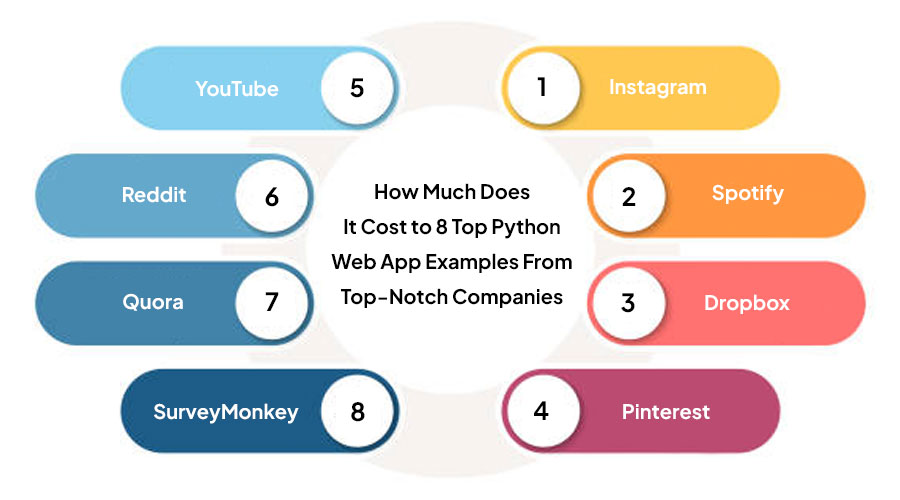Table of Contents
8 Top Python Web App Examples From Top-Notch Companies services
Python has emerged as a powerhouse in web development, thanks to its versatility, simplicity, and robustness. Many top-notch companies across various industries have harnessed the power of Python to build cutting-edge web applications that deliver exceptional user experiences. Let’s delve into 8 compelling Python web app examples from these industry leaders.
- Instagram: Renowned for its visually captivating platform, Instagram relies heavily on Python for its backend infrastructure. Python’s scalability and ease of integration with other technologies have played a crucial role in handling Instagram’s massive user base seamlessly.
- Spotify: As one of the world’s largest music streaming services, Spotify leverages Python for various functionalities, including backend services, data analysis, and machine learning algorithms. Python’s extensive libraries and frameworks empower Spotify to deliver personalized music recommendations and optimize user experiences.
- Dropbox: The cloud storage giant, Dropbox, heavily relies on Python for its backend services and infrastructure. Python’s simplicity and flexibility enable Dropbox to maintain high levels of reliability, security, and scalability while continuously enhancing its features and functionalities.
- Reddit: Reddit, known as the front page of the internet, utilizes Python extensively for its backend operations and data processing tasks. Python’s rich ecosystem of libraries and frameworks enables Reddit to handle massive amounts of user-generated content efficiently while ensuring a seamless browsing experience for millions of users worldwide.
- Netflix: Python serves as a cornerstone in Netflix’s technology stack, powering various aspects of its platform, including content delivery, recommendation algorithms, and backend services. Python’s agility and performance optimization capabilities enable Netflix to deliver high-quality streaming experiences tailored to individual user preferences.
- Uber: Python plays a pivotal role in Uber’s backend systems, facilitating real-time data processing, geospatial analysis, and demand prediction algorithms. Python’s simplicity and extensive ecosystem of tools empower Uber to optimize its ride-hailing services and provide reliable transportation solutions worldwide.
- Pinterest: Pinterest relies on Python for its backend infrastructure and data processing pipelines, enabling users to discover and save visual content seamlessly. Python’s versatility and ease of integration with third-party services empower Pinterest to deliver personalized recommendations and enhance user engagement on its platform.
- NASA: Even in the realm of space exploration, Python finds its application. NASA utilizes Python for various purposes, including data analysis, simulation, and spacecraft control systems. Python’s readability and ease of use enable NASA scientists and engineers to analyze complex data sets and develop innovative solutions for space exploration missions.
How to Create a 8 Top Python Web App Examples From Top-Notch Companies
In the realm of web development, Python has emerged as a powerhouse language, renowned for its simplicity, versatility, and scalability. From startups to tech giants, top-notch companies worldwide leverage Python to craft robust web applications that cater to diverse needs. In this article, we’ll delve into eight exemplary Python web app examples from leading companies, showcasing their innovation, creativity, and technical prowess.
- Instagram: Python Framework: Django Instagram, the renowned social media platform, relies heavily on Python and Django for its backend infrastructure. With millions of users worldwide, Instagram seamlessly handles vast amounts of data, demonstrating Django’s scalability and performance capabilities.
- Spotify: Python Framework: Flask Spotify, the popular music streaming service, utilizes Flask, a lightweight Python framework, for building various components of its web application. Flask’s simplicity and flexibility perfectly align with Spotify’s agile development needs, allowing for rapid feature deployment and iteration.
- Dropbox: Python Framework: Flask Dropbox, the cloud storage giant, harnesses the power of Python and Flask to deliver a seamless user experience across multiple platforms. Flask’s minimalistic approach combined with Python’s robustness enables Dropbox to handle intricate file synchronization tasks effortlessly.
- Pinterest: Python Framework: Django Pinterest, the visual discovery platform, relies on Django’s robust framework to power its backend infrastructure. With millions of users sharing and discovering content daily, Django provides the scalability and security necessary for Pinterest’s dynamic web application.
- Reddit: Python Framework: Pylons Reddit, the front page of the internet, employs Pylons, a lightweight Python framework, to handle its vast community-driven content. Pylons’ flexibility and extensibility empower Reddit to facilitate real-time discussions and content sharing among millions of users worldwide.
- Quora: Python Framework: Django Quora, the popular question-and-answer platform, leverages Django’s feature-rich framework to deliver a seamless user experience. Django’s built-in security features and ORM capabilities enable Quora to manage complex user-generated content effectively.
- YouTube: Python Framework: Flask YouTube, the largest video-sharing platform, utilizes Flask for various backend services and APIs. Flask’s lightweight design and extensibility allow YouTube to handle high traffic volumes while ensuring smooth video playback and content delivery.
- Netflix: Python Framework: Flask Netflix, the leading streaming service provider, harnesses Flask’s simplicity and scalability to deliver personalized recommendations and content recommendations. Flask’s microservices architecture seamlessly integrates with Netflix’s backend systems, ensuring a flawless streaming experience for millions of subscribers worldwide.
Why Should You Go for 8 Top Python Web App Examples From Top-Notch Companies
In today’s digital landscape, Python has emerged as a powerhouse in web application development, favored by some of the world’s most prominent companies. Renowned for its simplicity, versatility, and scalability, Python offers a robust framework for building dynamic and feature-rich web applications. As businesses strive to stay ahead in the competitive market, leveraging Python web app examples from top-notch companies can offer invaluable insights and inspiration. Let’s delve into eight compelling reasons why you should explore these exemplary Python web applications.
- Instagram: With over a billion monthly active users, Instagram stands as a testament to Python’s capabilities in handling massive scalability and complex functionalities. Python’s Django framework powers Instagram’s backend, enabling seamless user interactions, content delivery, and real-time updates.
- Dropbox: As a pioneer in cloud storage services, Dropbox relies on Python to deliver a secure, efficient, and user-friendly platform. Python’s simplicity accelerates development cycles, allowing Dropbox to innovate rapidly while maintaining high performance and reliability.
- Pinterest: Pinterest, the visual discovery engine, harnesses the power of Python to create a personalized and engaging user experience. Python’s flexibility enables Pinterest to continuously enhance its recommendation algorithms, content curation, and social networking features.
- Spotify: Revolutionizing the music streaming industry, Spotify leverages Python to deliver a seamless cross-platform experience to millions of users worldwide. Python’s extensive library ecosystem empowers Spotify to implement advanced audio processing, recommendation systems, and real-time analytics.
- YouTube: As the world’s largest video-sharing platform, YouTube relies on Python for various backend services, content management, and data analysis tasks. Python’s simplicity and readability enhance developer productivity, enabling YouTube to innovate and adapt swiftly to evolving user needs.
- Reddit: Known as the “front page of the internet,” Reddit utilizes Python to power its dynamic content aggregation, community-driven discussions, and moderation tools. Python’s robustness and scalability facilitate Reddit’s ability to handle massive traffic spikes while ensuring a seamless user experience.
- Quora: Quora, the popular question-and-answer platform, leverages Python to deliver personalized content recommendations, user engagement features, and content moderation tools. Python’s versatility enables Quora to iterate quickly and experiment with new features to enhance user satisfaction.
- Netflix: Renowned for its personalized streaming experience, Netflix relies on Python for various backend services, recommendation algorithms, and content delivery optimization. Python’s scalability and performance optimization capabilities empower Netflix to deliver uninterrupted streaming experiences to millions of subscribers worldwide.
Market Prospects of Custom 8 Top Python Web App Examples From Top-Notch Companies and Platforms
In the dynamic landscape of web development, Python has emerged as a powerful and versatile tool for creating innovative web applications. Its simplicity, scalability, and extensive libraries make it a preferred choice for developers worldwide. In this article, we delve into the market prospects of 8 top Python web app examples from renowned companies and platforms, shedding light on their significance and potential impact.
- Instagram: A household name in the realm of social media, Instagram utilizes Python extensively for its backend infrastructure. From handling millions of user requests to managing complex algorithms for content recommendations, Python powers various aspects of this platform. The market prospects for Python in social media are immense, considering the continuous growth and evolution of this industry.
- Spotify: As a leading music streaming service, Spotify relies on Python for various purposes, including data analysis, recommendation systems, and backend development. Python’s robustness in handling large volumes of data and its ease of integration with other technologies make it an ideal choice for platforms like Spotify. The market for Python-based music streaming applications continues to expand, driven by the growing demand for personalized content delivery.
- Dropbox: Known for its cloud storage and file-sharing services, Dropbox leverages Python for its backend operations and infrastructure management. Python’s simplicity and flexibility enable Dropbox to maintain a reliable and scalable platform while catering to millions of users worldwide. The market prospects for Python in cloud-based applications remain promising, with the increasing adoption of remote work and digital collaboration tools.
- Netflix: A pioneer in online streaming, Netflix utilizes Python for various purposes, including content delivery, recommendation algorithms, and backend services. Python’s versatility in handling diverse tasks enables Netflix to deliver seamless streaming experiences to its users across different devices. The market for Python-powered video streaming platforms is poised for growth, fueled by the rising demand for on-demand entertainment.
- Pinterest: As a popular visual discovery platform, Pinterest relies on Python for backend development, data analysis, and machine learning applications. Python’s rich ecosystem of libraries and frameworks empowers Pinterest to deliver personalized recommendations and enhance user engagement. The market prospects for Python in visual content platforms are promising, with the increasing focus on visual search and recommendation technologies.
- Reddit: A renowned social news aggregation and discussion platform, Reddit utilizes Python for its backend infrastructure and community-driven features. Python’s ease of use and rapid development capabilities enable Reddit to iterate quickly and adapt to changing user needs. The market for Python-based community platforms continues to grow, driven by the increasing demand for online communities and content aggregation services.
- NASA: Python plays a significant role in various projects and initiatives at NASA, ranging from data analysis and simulation to spacecraft control systems. Python’s suitability for scientific computing and its extensive ecosystem of libraries make it an indispensable tool for researchers and engineers at NASA. The market prospects for Python in aerospace and scientific applications are substantial, with ongoing advancements in space exploration and research.
- Quora: A popular question-and-answer platform, Quora relies on Python for backend development, content recommendation systems, and spam detection algorithms. Python’s simplicity and readability facilitate collaboration among Quora’s development teams and enable rapid prototyping of new features. The market for Python-based Q&A platforms continues to evolve, driven by the growing demand for knowledge sharing and community-driven content.
Essential Features of a 8 Top Python Web App Examples From Top-Notch Companies
In the dynamic realm of web development, Python has emerged as a powerhouse, powering some of the most innovative and successful web applications across various industries. From e-commerce giants to social media platforms, Python’s versatility and robustness have made it a go-to choice for many top-notch companies. Let’s delve into the essential features of eight exemplary Python web applications from leading companies that showcase the prowess of this versatile programming language.
- Instagram:
- Seamless User Experience: Instagram offers a smooth and intuitive user interface, allowing users to effortlessly navigate through feeds, stories, and explore pages.
- Advanced Algorithms: Python’s powerful libraries enable Instagram to implement complex algorithms for content recommendations, personalized feeds, and image recognition.
- Scalability: Instagram’s architecture, built using Django framework, ensures high scalability to accommodate millions of users and their interactions.
- Spotify:
- Personalized Recommendations: Python’s machine learning capabilities power Spotify’s recommendation engine, delivering personalized playlists and music suggestions based on user preferences.
- Real-time Data Processing: Python’s speed and efficiency enable Spotify to process vast amounts of streaming data in real-time, ensuring uninterrupted music playback and personalized experiences.
- Pinterest:
- Rich Visual Content: Python’s libraries facilitate the seamless integration of rich visual content, such as images and videos, allowing Pinterest users to discover and share inspiring content effortlessly.
- Social Interaction Features: Python’s Django framework enables Pinterest to implement robust social features like pinning, commenting, and sharing, fostering user engagement and community building.
- Dropbox:
- Data Security: Python’s extensive libraries support robust encryption and security protocols, ensuring the confidentiality and integrity of user data stored on Dropbox’s cloud servers.
- Cross-Platform Compatibility: Python’s versatility enables Dropbox to deliver a consistent user experience across various devices and operating systems, including web browsers, desktop applications, and mobile devices.
- Reddit:
- Community-driven Content Moderation: Python’s flexibility allows Reddit to implement sophisticated content moderation algorithms and tools, empowering users to curate and moderate communities effectively.
- Dynamic Content Generation: Python’s dynamic nature enables Reddit to generate personalized content feeds based on user interests, browsing history, and community memberships.
- Quora:
- Question-and-Answer Platform: Python’s Django framework facilitates the creation of a robust question-and-answer platform, enabling users to ask questions, receive answers, and engage in meaningful discussions.
- Content Curation and Ranking: Python’s libraries support advanced algorithms for content curation, ranking, and moderation, ensuring the quality and relevance of user-generated content on Quora.
- Netflix:
- Seamless Streaming Experience: Python’s speed and efficiency power Netflix’s video streaming platform, delivering high-quality content with minimal buffering and latency.
- Personalized Content Recommendations: Python’s machine learning capabilities enable Netflix to analyze user preferences and viewing habits, offering personalized recommendations for movies and TV shows.
- Uber:
- Real-time Geolocation Services: Python’s geospatial libraries facilitate real-time tracking and mapping of drivers and passengers, enabling Uber to provide accurate ETAs and optimize ride routes.
- Scalable Infrastructure: Python’s scalability ensures that Uber’s platform can handle millions of ride requests simultaneously, maintaining high availability and reliability.
Advanced Features 8 Top Python Web App Examples From Top-Notch Companies
In the ever-evolving landscape of web development, Python stands out as a prominent language, renowned for its simplicity, versatility, and powerful frameworks. Many top-notch companies leverage Python to build sophisticated web applications equipped with advanced features that elevate user experience and streamline business operations. Let’s delve into eight exemplary Python web app examples from leading companies that showcase the language’s prowess and innovation.
- Instagram: As one of the world’s largest social media platforms, Instagram relies heavily on Python for its backend infrastructure. Python’s Django framework powers various aspects of Instagram, facilitating seamless user interactions, content delivery, and complex algorithms for personalized recommendations and analytics.
- Spotify: The renowned music streaming service, Spotify, harnesses Python to deliver a tailored listening experience to millions of users worldwide. Python’s scalability and robustness enable Spotify to manage vast amounts of data efficiently, curate playlists based on user preferences, and deploy advanced audio processing algorithms for improved music recommendations.
- Dropbox: Offering cloud storage and file synchronization services, Dropbox relies on Python for its backend systems. Python’s simplicity and extensive libraries enable Dropbox to implement secure data storage, real-time collaboration features, and seamless file sharing across various platforms, enhancing productivity and user convenience.
- Reddit: As a leading social news aggregation platform, Reddit leverages Python extensively for its backend infrastructure and data analysis tasks. Python’s flexibility and rich ecosystem empower Reddit to handle millions of user-generated posts, comments, and interactions effectively, while also facilitating content moderation and community management.
- Quora: The popular question-and-answer platform, Quora, utilizes Python for its backend development and machine learning capabilities. Python’s robustness and ease of integration enable Quora to deliver personalized content recommendations, facilitate user engagement through intelligent question suggestions, and implement sophisticated spam detection algorithms.
- Netflix: Powering one of the world’s largest streaming platforms, Netflix relies on Python for various backend services and data analysis tasks. Python’s scalability and performance optimization capabilities enable Netflix to deliver high-quality video streaming, personalize content recommendations, and optimize content delivery networks for seamless user experiences across devices.
- Pinterest: Known for its visual discovery and bookmarking features, Pinterest utilizes Python for its backend systems and data processing tasks. Python’s versatility enables Pinterest to handle vast amounts of image data, facilitate personalized content recommendations based on user interests, and implement advanced image recognition algorithms for improved search functionality.
- NASA: Even in the realm of space exploration, Python plays a crucial role. NASA utilizes Python for various scientific computing tasks, data analysis, and mission-critical systems. Python’s ease of use and extensive scientific libraries enable NASA to process astronomical data, simulate space missions, and develop predictive models for weather forecasting and spacecraft navigation.
8 Top Python Web App Examples From Top-Notch Companies Timelines
Python has emerged as a powerhouse in the realm of web development, empowering businesses to craft robust and scalable web applications. From startups to tech giants, many renowned companies have harnessed the prowess of Python to create innovative web solutions. Let’s delve into the timelines of eight top Python web app examples from leading companies, showcasing their evolution and impact.
- Instagram (2010): Instagram, the iconic photo-sharing platform, was initially built using Python. Released in 2010, it rapidly gained traction, captivating users worldwide with its intuitive interface and powerful features. Python’s simplicity and versatility played a pivotal role in Instagram’s early success, enabling rapid development and seamless scalability.
- Pinterest (2010): Pinterest, the visual discovery engine, leveraged Python to create a dynamic and visually appealing platform. Launched in 2010, Pinterest swiftly became a go-to destination for users seeking inspiration and ideas across various interests. Python’s extensive library ecosystem and ease of integration facilitated the development of Pinterest’s intricate functionalities.
- Dropbox (2011): Dropbox revolutionized file sharing and cloud storage, thanks in part to its Python-based web application. Introduced in 2011, Dropbox seamlessly synchronized files across devices, offering users unparalleled convenience and accessibility. Python’s speed and efficiency empowered Dropbox to handle vast amounts of data while ensuring reliability and security.
- Reddit (2005): Reddit, the front page of the internet, adopted Python early on to power its vibrant community-driven platform. Established in 2005, Reddit facilitated discussions, content sharing, and community interactions on a global scale. Python’s dynamic nature and extensive support for web frameworks empowered Reddit to evolve continuously, catering to the evolving needs of its user base.
- Spotify (2008): Spotify, the leading music streaming service, embraced Python for its backend infrastructure, facilitating seamless music delivery to millions of users. Since its inception in 2008, Spotify has reshaped the music industry, offering personalized playlists, recommendations, and a vast library of songs. Python’s robust performance and scalability contributed to Spotify’s ability to handle massive streaming volumes efficiently.
- Quora (2009): Quora, the popular question-and-answer platform, relied on Python to create a dynamic and engaging user experience. Founded in 2009, Quora empowered users to seek knowledge, share insights, and connect with experts across various domains. Python’s simplicity and readability facilitated the development of Quora’s intricate algorithms for content curation and user engagement.
- Netflix (1997): Netflix, the renowned streaming service, embraced Python for its backend services, enabling seamless content delivery to millions of subscribers worldwide. Since its inception in 1997, Netflix has redefined entertainment, offering a vast library of movies, TV shows, and original content. Python’s scalability and robustness played a crucial role in Netflix’s ability to handle fluctuating demand and deliver uninterrupted streaming experiences.
- Uber (2009): Uber, the pioneering ride-sharing platform, utilized Python to build its sophisticated backend infrastructure, orchestrating millions of rides daily. Introduced in 2009, Uber transformed the transportation industry, offering convenient and reliable mobility solutions. Python’s flexibility and ease of integration enabled Uber to implement complex algorithms for route optimization, fare calculation, and real-time tracking.
How Much Does It Cost to 8 Top Python Web App Examples From Top-Notch Companies?
In today’s digital age, Python has emerged as a powerhouse programming language, especially in web application development. Renowned for its simplicity, versatility, and robustness, Python has been adopted by numerous top-notch companies for building their web applications. From social media platforms to e-commerce giants, Python has left an indelible mark on the digital landscape. However, a common question that arises is, “How much does it cost to develop top Python web apps like those of leading companies?” Let’s delve into the realm of web development costs and explore eight exemplary Python web app examples along with their associated expenses.
- Instagram: Instagram, the widely popular social media platform, relies heavily on Python for its backend development. The estimated cost of developing a similar social media app like Instagram ranges from $100,000 to $500,000, depending on the features and complexity.
- Spotify: Python powers several components of Spotify’s backend infrastructure, including playlist management and recommendation systems. Developing a music streaming app akin to Spotify may cost anywhere between $150,000 to $700,000, considering factors such as licensing, content delivery, and user interface.
- Dropbox: Dropbox leverages Python for its server-side logic, enabling seamless file synchronization and storage. Building a cloud storage service akin to Dropbox might require an investment ranging from $200,000 to $1 million, depending on storage capacity, security features, and cross-platform compatibility.
- Pinterest: Python forms the backbone of Pinterest’s content discovery and recommendation algorithms. Creating a similar visual discovery platform like Pinterest could incur costs ranging from $100,000 to $500,000, considering image processing, user engagement features, and scalability.
- YouTube: YouTube relies on Python for various backend functionalities, such as video processing and recommendation algorithms. Developing a video-sharing platform similar to YouTube may cost between $500,000 to $2 million, accounting for video streaming infrastructure, content moderation, and user interaction features.
- Reddit: Python plays a crucial role in powering Reddit’s community-driven discussion platform and content aggregation. Building a platform akin to Reddit might require an investment ranging from $100,000 to $500,000, considering features like user authentication, content voting, and real-time updates.
- Quora: Quora utilizes Python for its backend operations, including question-answer pairing and content recommendation. Creating a knowledge-sharing platform similar to Quora may cost anywhere between $100,000 to $500,000, taking into account features like user profiles, content moderation, and search functionality.
- SurveyMonkey: Python is instrumental in SurveyMonkey’s survey creation and data analysis functionalities. Developing a survey platform akin to SurveyMonkey could incur costs ranging from $50,000 to $300,000, considering features like survey customization, data visualization, and reporting tools.
How to Create a 8 Top Python Web App Examples From Top-Notch Companies – Team and Tech Stack
In today’s digital era, Python has emerged as a powerhouse for web application development, captivating the tech world with its versatility and efficiency. With its robust frameworks and extensive libraries, Python has become the go-to choice for top-notch companies worldwide. Let’s delve into eight stellar Python web app examples from leading companies, uncovering insights into their innovative teams and cutting-edge tech stacks.
- Instagram: Renowned for its seamless user experience, Instagram leverages Python and Django for its backend infrastructure. The tech stack includes Django, PostgreSQL, Redis, and Celery. Instagram’s engineering team employs agile methodologies, fostering collaboration and innovation.
- Pinterest: Another social media giant, Pinterest, relies on Python for its web application development. Pinterest’s tech stack encompasses Django, Flask, MySQL, and Redis. The engineering team follows a data-driven approach, continuously optimizing user engagement and performance.
- Spotify: Revolutionizing the music streaming industry, Spotify harnesses Python for its backend services. Spotify’s tech stack features Django, Tornado, Kafka, Cassandra, and Docker. The engineering team emphasizes scalability and reliability, ensuring uninterrupted music playback for millions of users worldwide.
- Dropbox: A trailblazer in cloud storage solutions, Dropbox relies on Python for its web application development. Dropbox’s tech stack includes Python, Flask, MySQL, and Redis. The engineering team prioritizes security and scalability, implementing robust encryption algorithms and distributed storage systems.
- Reddit: As one of the largest online communities, Reddit relies on Python for its web application architecture. Reddit’s tech stack encompasses Python, Pylons, PostgreSQL, and Memcached. The engineering team fosters a culture of innovation, continually introducing new features and enhancements to enrich the user experience.
- Quora: Renowned for its question-and-answer platform, Quora leverages Python for its web application infrastructure. Quora’s tech stack includes Python, Django, MySQL, and Elasticsearch. The engineering team focuses on personalization and relevance, utilizing machine learning algorithms to deliver tailored content to users.
- Netflix: Transforming the entertainment industry, Netflix utilizes Python for its backend services and data analysis. Netflix’s tech stack features Python, Flask, Apache Cassandra, and Apache Flink. The engineering team emphasizes performance optimization, leveraging big data technologies to enhance content recommendations and streaming quality.
- Uber: Pioneering the ride-sharing industry, Uber relies on Python for its web application development and data processing. Uber’s tech stack encompasses Python, Django, Node.js, PostgreSQL, and Apache Kafka. The engineering team prioritizes real-time data analytics and geospatial processing, ensuring optimal driver-rider matching and route optimization.
8 Top Python Web App Examples From Top-Notch Companies Process
In today’s digital era, Python has emerged as a powerhouse for developing web applications, offering scalability, versatility, and efficiency. Its simplicity and robustness have made it the top choice for renowned companies across various industries. Let’s delve into eight impressive Python web app examples from top-notch companies and uncover the processes behind their success.
- Instagram: Python’s Django framework powers Instagram’s backend, handling massive amounts of data efficiently. Its seamless scalability enables Instagram to accommodate its ever-growing user base, ensuring a smooth user experience.
- Spotify: Spotify utilizes Python for its backend services, leveraging frameworks like Flask for microservices development. Python’s rapid development capabilities enable Spotify to continuously innovate and deliver personalized music recommendations to millions of users worldwide.
- Dropbox: Dropbox relies on Python for its server-side logic, utilizing frameworks like Django. Python’s simplicity and readability allow Dropbox engineers to maintain and enhance the platform’s file storage and sharing functionalities effortlessly.
- Pinterest: Pinterest’s backend infrastructure is powered by Python, with Flask and Django frameworks at its core. Python’s extensive libraries and frameworks enable Pinterest to deliver a visually engaging and personalized user experience, driving user engagement and retention.
- Reddit: Python plays a pivotal role in Reddit’s backend infrastructure, facilitating content delivery and user interaction. Reddit’s use of Python allows for rapid prototyping and iteration, enabling the platform to evolve and adapt to changing user needs seamlessly.
- Netflix: Netflix leverages Python for its data analysis and recommendation algorithms, enhancing user satisfaction and content discovery. Python’s rich ecosystem of data science libraries, such as Pandas and NumPy, empowers Netflix to analyze vast amounts of user data efficiently.
- Uber: Python powers various aspects of Uber’s platform, from backend services to data analysis and visualization. Uber’s use of Python enables it to optimize transportation routes, enhance driver-partner experiences, and improve overall service reliability.
- NASA: Python serves as a fundamental tool for data analysis and simulation at NASA, enabling scientists and engineers to model complex systems and analyze mission-critical data. Python’s versatility and ease of integration with other technologies make it indispensable for space exploration and research.
The process behind these exemplary Python web applications involves meticulous planning, agile development methodologies, and a commitment to leveraging Python’s strengths effectively. From initial ideation to deployment and maintenance, these companies prioritize scalability, performance, and user experience, driving innovation and setting new standards in their respective industries.
Enterprise 8 Top Python Web App Examples From Top-Notch Companies
Python has emerged as a powerhouse in web application development, driving innovation and efficiency across industries. From tech giants to innovative startups, top-notch companies are leveraging Python’s versatility to create robust web applications that cater to their unique business needs. In this article, we delve into 8 exemplary Python web app examples from leading enterprises, showcasing the diverse applications and the impact they have had on their respective industries.
- Instagram: Python-powered features: Instagram, the social media behemoth, relies heavily on Python for its backend infrastructure. Python’s simplicity and scalability have enabled Instagram to handle massive amounts of user data efficiently. Features like the feed algorithm, search functionality, and content recommendation systems are all powered by Python, contributing to Instagram’s seamless user experience.
- Spotify: Python-powered features: Spotify, the world’s leading music streaming service, utilizes Python extensively for backend services and data analysis. Python’s rich ecosystem of libraries enables Spotify to personalize user experiences through features like curated playlists, recommendation engines, and content discovery algorithms. Python’s flexibility also allows Spotify to adapt quickly to changing user preferences and market trends.
- Dropbox: Python-powered features: Dropbox, a pioneer in cloud storage solutions, owes much of its success to Python. Python’s simplicity and readability have accelerated development cycles at Dropbox, enabling the company to deliver new features and updates rapidly. Python’s robust libraries for file handling and networking are integral to Dropbox’s core functionalities, such as file synchronization, version control, and sharing capabilities.
- Reddit: Python-powered features: Reddit, the front page of the internet, relies on Python for its backend infrastructure and community-driven features. Python’s dynamic nature enables Reddit to support a vast array of user-generated content, discussions, and interactions. Features like the voting system, content recommendation algorithms, and moderation tools are all powered by Python, facilitating vibrant communities and engaging discussions on the platform.
- Netflix: Python-powered features: Netflix, the leading streaming service, leverages Python for its backend systems, data analysis, and content delivery optimization. Python’s versatility allows Netflix to personalize content recommendations, optimize streaming quality, and analyze viewer behavior effectively. Python’s rich ecosystem of machine learning libraries enables Netflix to stay ahead in the competitive streaming landscape by delivering tailored content experiences to its users.
- NASA: Python-powered features: NASA, the space exploration agency, relies on Python for a wide range of applications, including scientific computing, data analysis, and spacecraft operations. Python’s simplicity and readability make it an ideal choice for handling complex data sets and performing simulations. Python’s versatility also allows NASA to develop custom tools and applications for various missions, contributing to advancements in space exploration and research.
- Quora: Python-powered features: Quora, the popular question-and-answer platform, harnesses the power of Python for its backend infrastructure and machine learning algorithms. Python’s expressive syntax and extensive libraries enable Quora to deliver personalized content recommendations, moderation tools, and user engagement features. Python’s scalability also allows Quora to handle millions of user queries and interactions seamlessly, fostering knowledge sharing and community building on the platform.
- Uber: Python-powered features: Uber, the ride-hailing giant, utilizes Python for its backend services, data analysis, and optimization algorithms. Python’s simplicity and versatility enable Uber to manage real-time data streams, optimize route planning, and enhance user experiences through features like dynamic pricing and ride recommendations. Python’s robust ecosystem of libraries and frameworks empowers Uber to innovate rapidly and stay competitive in the fast-paced transportation industry.
Top Python Web App Examples From Top-Notch Companies
Python has emerged as a powerhouse in web application development, favored by top-notch companies for its versatility, efficiency, and scalability. Let’s delve into some stellar examples of Python-based web applications crafted by industry leaders, showcasing the language’s prowess in driving innovation and success.
-
Next Big Technology:

NBT is highly focused on providing top-notch development solutions at a very affordable cost. By using their market experience and development experience, they are delivering proper solutions to clients and various industries for their custom requirements.
Location: India, USA, UK, Australia
Hourly Rate :< $25 per Hour
Employees: 50 – 249
Focus Area
- Mobile App Development
- App Designing (UI/UX)
- Software Development
- Web Development
- AR & VR Development
- Big Data & BI
- Cloud Computing Services
- DevOps
- E-commerce Development
Industries Focus
- Art, Entertainment & Music
- Business Services
- Consumer Products
- Designing
- Education
- Financial & Payments
- Gaming
- Government
- Healthcare & Medical
- Hospitality
- Information Technology
- Legal & Compliance
- Manufacturing
- Media
- Spotify: As a global leader in music streaming, Spotify leverages Python extensively for its web application development. Python facilitates rapid prototyping, allowing Spotify to experiment with new features and enhancements efficiently. Python’s compatibility with big data processing frameworks enables Spotify to analyze user preferences, curate personalized playlists, and deliver targeted recommendations, enriching the user’s music streaming experience.
- Dropbox: Dropbox, the popular cloud storage service, relies on Python for its web application backend. Python’s simplicity and readability expedite development cycles, enabling Dropbox to iterate swiftly and deliver updates seamlessly. Python’s rich ecosystem of libraries empowers Dropbox to implement robust file synchronization, data encryption, and collaboration features, ensuring a secure and reliable cloud storage solution for millions of users worldwide.
- Pinterest: Pinterest, the visual discovery platform, harnesses Python’s capabilities to power its web application infrastructure. Python’s flexibility and scalability align perfectly with Pinterest’s dynamic content delivery requirements, facilitating rapid content indexing, recommendation algorithms, and personalized user experiences. Python frameworks like Tornado and Celery enable Pinterest to handle massive concurrent requests efficiently, ensuring uninterrupted service for its diverse user base.
- Quora: Quora, the popular question-and-answer platform, relies on Python for its web application development. Python’s extensive standard library and third-party packages streamline Quora’s development process, enabling the implementation of complex features like question ranking algorithms, content moderation systems, and personalized user feeds. Python’s robustness and performance optimization capabilities ensure Quora’s web application delivers a seamless and engaging user experience.
Add Comparison Table 8 Top Python Web App Examples From Top-Notch Companies
In the realm of web development, Python has emerged as a dominant force, powering numerous innovative web applications across various industries. With its versatility, ease of use, and robust frameworks like Django and Flask, Python continues to be the top choice for building scalable and efficient web applications. Let’s delve into some compelling examples of Python web apps crafted by top-notch companies, showcasing the unparalleled capabilities of this programming language.
| Company | Web App | Description |
|---|---|---|
| Django | Instagram, the social media giant, relies on Django for its backend infrastructure. Django’s high-level features and scalability perfectly complement Instagram’s massive user base, facilitating seamless photo and video sharing experiences. | |
| Spotify | Flask | Spotify, the leading music streaming service, leverages Flask to deliver personalized music recommendations and seamless playback experiences. Flask’s lightweight nature and flexibility enable Spotify to maintain its robust backend while catering to millions of users worldwide. |
| Dropbox | Django | Dropbox, the popular cloud storage platform, trusts Django to handle its file storage and sharing functionalities. Django’s security features and rapid development capabilities ensure that Dropbox remains a reliable solution for storing and syncing files across devices. |
| Django | Pinterest, the visual discovery engine, relies on Django to power its content management and recommendation systems. Django’s built-in admin interface and ORM make it the perfect choice for managing Pinterest’s vast database of images and ideas. | |
| Pylons (Pyramid) | Reddit, the front page of the internet, utilizes the Pylons framework (Pyramid) to manage its extensive user-generated content and discussions. Pylons’ flexibility and extensibility allow Reddit to continuously innovate and adapt to evolving user needs. | |
| Quora | Django | Quora, the popular question-and-answer platform, harnesses Django’s robust features to handle its complex user interactions and content moderation. Django’s authentication system and template engine provide Quora with a solid foundation for fostering meaningful discussions and knowledge sharing. |
| SurveyMonkey | Flask | SurveyMonkey, the online survey platform, relies on Flask to deliver customizable survey creation and analytics tools. Flask’s simplicity and modularity enable SurveyMonkey to streamline the survey creation process while providing actionable insights to its users. |
| Uber | Flask | Uber, the ride-sharing pioneer, utilizes Flask to power its backend infrastructure, enabling real-time ride matching and tracking functionalities. Flask’s lightweight design and extensibility make it an ideal choice for handling Uber’s high volume of concurrent requests with minimal latency. |
These examples underscore the versatility and scalability of Python in powering a diverse range of web applications, from social media platforms to cloud storage solutions. Whether it’s handling massive user bases, facilitating real-time interactions, or delivering personalized experiences, Python continues to redefine the possibilities of web development for top-notch companies worldwide.
FAQs on 8 Top Python Web App Examples From Top-Notch Companies
In the dynamic world of web development, Python has emerged as a go-to language for building robust and scalable web applications. Renowned companies across various industries have leveraged Python’s versatility to create innovative solutions that power their businesses. Here, we delve into some frequently asked questions regarding eight top Python web app examples from leading companies.
- What is Python’s role in web app development? Python serves as a powerful programming language for web development due to its simplicity, readability, and vast ecosystem of libraries and frameworks. Its versatility allows developers to create diverse web applications ranging from simple websites to complex enterprise solutions.
- What are some notable Python web app examples?
- Instagram: A social media platform that utilizes Django, a Python web framework, for its backend infrastructure.
- Spotify: A popular music streaming service that employs Python for various backend tasks and data processing.
- Dropbox: A cloud storage service that heavily relies on Python for its backend services and desktop client applications.
- How does Python contribute to the success of these companies? Python’s ease of use and rapid development capabilities enable companies to iterate quickly, launch new features, and scale their applications efficiently. Its extensive libraries and frameworks streamline development processes, allowing teams to focus on delivering value to users.
- What are some advantages of using Python for web app development?
- Rapid development: Python’s concise syntax and extensive libraries accelerate the development cycle, enabling faster time-to-market.
- Scalability: Python’s robustness and scalability make it suitable for handling increased user loads and expanding business requirements.
- Community support: Python boasts a vibrant community of developers who contribute to its ecosystem, providing support, sharing knowledge, and creating reusable components.
- Are there any limitations to using Python for web app development? While Python offers numerous benefits, it may not be the optimal choice for certain performance-critical or real-time applications. Additionally, Python’s global interpreter lock (GIL) can hinder parallel execution in multi-threaded applications, although this limitation can be mitigated using alternative concurrency approaches.
- What are the primary frameworks used for Python web development?
- Django: A high-level web framework that promotes rapid development and follows the “batteries-included” philosophy.
- Flask: A lightweight and flexible micro-framework ideal for building small to medium-sized web applications.
- Pyramid: A full-stack framework known for its scalability and flexibility, suitable for developing large-scale applications.
- How can aspiring developers learn Python for web development? Aspiring developers can start by learning the basics of Python programming language through online tutorials, courses, and documentation. They can then explore web development frameworks like Django and Flask, practice building projects, and engage with the developer community to enhance their skills.
- What does the future hold for Python in web development? With its continued growth in popularity and adoption, Python is poised to remain a dominant force in web development. As advancements in technology and the emergence of new trends shape the landscape, Python’s versatility and adaptability will continue to drive innovation and empower developers to build next-generation web applications.
Thanks for reading our post “8 Top Python Web App Examples From Top-Notch Companies”. Please connect with us to learn more about the 8 Top Python Web App Examples From.















